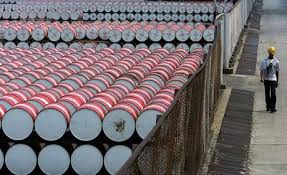 WTI and Brent futures declined during afternoon trade in Europe today, as the US posted weekly figures on oil inventories. Iraq saw intense fighting, but exports seemed safe enough. Meanwhile, natural gas futures were steady, while US weather patterns project warmer days this week.
WTI and Brent futures declined during afternoon trade in Europe today, as the US posted weekly figures on oil inventories. Iraq saw intense fighting, but exports seemed safe enough. Meanwhile, natural gas futures were steady, while US weather patterns project warmer days this week.
West Texas Intermediate futures for settlement in July traded for $106.29 per barrel at 14:43 GMT on the New York Mercantile Exchange, down 0.07%. Prices ranged from $106.25 to $106.97 per barrel. The US contract dropped 0.51% yesterday, after logging no change on Monday. Last week saw a nine-month high for WTI.
Meanwhile on the ICE in London, Brent futures due in August stood for a 0.08% gain at $113.54 per barrel at 14:44 GMT. Daily high and low stood at $113.85 and $113.05 per barrel, respectively. Brent’s premium to August WTI stood at $7.69, after last session’s closing margin of $7.58. The European contract added 0.45% on Tuesday, after a further 0.43% gain on Monday. Brent also recorded a nine-month high last week.
US oil inventories
The US Energy Information Administration (EIA) posted its weekly oil inventories report for the seven day through June 13 today. The log revealed a 0.579 million-barrel drop, after the private American Petroleum Institute (API) had suggested a 5.7 million-barrel drop on Tuesday. A Bloomberg survey projected a 0.750 million-barrel gain. The previous reading, for the week through June 6, showed crude inventories had lost 2.6 million barrels.
Oil at Cushing, Oklahoma, the delivery point for the NYMEX contract and the largest hub in the US, was reported at 21.4 million barrels for a 0.2 million-barrel gain, after a drop of 200 000 was logged for the previous week. Meanwhile, hubs at the Gulf Coast dropped 1.2 million barrels, after further 100 000 were drawn last week. Previously, the week ended May 30 saw a massive 6-million-barrel drop for hubs at the Gulf.
Domestic production of crude oil was logged at 8.477 million barrels per day (bpd), for a second minor weekly growth. Meanwhile, imports of crude were at 7.234 million bpd, 90 000 bpd more than last week. Inbound shipments of crude have declined by about 1.4 million bpd over the past month, almost 20% of current imports.
Gasoline inventories added 0.785 million barrels for the week through June 13, while the API had reported a 48 000-barrel decline, after last week saw 1.7 million barrels added. Distillate fuels stockpiles levels grew by 0.436 million barrels, while the API posted a 0.531 million-barrel gain on Tuesday. Previously, distillates inventories had added 0.9 million barrels in the week through June 6.
Refinery utilization rate was slightly down for a standing of 87.1%, after a 3% drop was logged in the previous reading. Gasoline production this week grew by almost 1 million bpd, more than 10%, for a standing of 9.840 million bpd. A 0.6 million-bpd decline was recorded last week. Distillates output averaged 4.732 million bpd with a weekly decline of 100 000 bpd, after a 0.4 million-bpd decline was reported last week.
Iraq
Sunni militants, led by a group of extremists called ISIS (Islamic State in Iraq and the Levant), continue to advance towards the Iraqi capital of Baghdad. Bitter fighting was reported some 60km north of the city, while more battles were fought to the west of Baghdad. Citizens have been reported to be stockpiling food and water, the BBC reported. Militants had also claimed a reported 75% of the country’s largest oil refinery at the northern town of Baiji.
Meanwhile, the Iraqi military commander of the province of Nineveh, which first came under attack from the Islamist, was dismissed by the Iraqi government, for failing to stop the militants from taking key cities. The city of Tikrit was said to house some 30 000-strong garrison of government troops, who fled when attacked by only several hundred insurgents.
Authorities have assured the populace that the rebels will not take Baghdad, and that food supplies are not in danger. They have also expressed confidence in a planned rapid counteroffensive. Also, they reinstated that the southern oilfields, which account for 90% of Iraqi oil output, were completely safe.
“Exports haven’t been affected yet, so the price gain weve seen so far is only on speculation that things might deteriorate further and instability will spread to the south of Iraq,” Ben Le Brun, a markets analyst at OptionsXpress in Sydney, said for Reuters. “But as soon as we hear about production affected, then we will start to see the price move up more dramatically. But it’s very hard to put a figure on this. In a worst case scenario, Brent could go above $120 at a minimum.”
Natural gas
Front month natural gas futures, due in July, dropped 0.28% at the New York Mercantile Exchange to trade for $4.696 per million British thermal units at 14:45 GMT today. Prices ranged from $4.683 to $4.773 per mBtu. The contract added 0.04%, after a 0.68% drop yesterday, though it did reach a five-week high at $4.886 per mBtu.
The report for the week through June 13 is due this Thursday, and will probably reveal a gain of about 105 Billion cubic feet (Bcf), NatGasWeather.com said, which would be 20 Bcf more than the 5-year average gain for the period. The above-normal temperatures will dent gains this and the following week, with more heat at the start of July.
Power demand usually spikes during summer, as air conditioners are put to work, and power stations account for 30% of US natural gas consumption. Usually there is a direct correlation between rising summer temperatures and natural gas prices.





